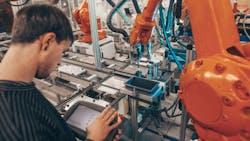Leveraging smart factories to adopt data-driven approaches
The manufacturing sector is navigating a perfect storm of challenges: skilled labor shortages, ongoing supply chain disruptions, and economic headwinds. These pressures are pushing companies to innovate—to “Industry 4.0”—to remain competitive. Smart factories represent the end goal of digital transformation in manufacturing. These data-driven facilities offer a powerful solution by enhancing efficiency and productivity in this age.
In a recent report on the State of Smart Manufacturing, the skilled worker shortage and deploying and integrating new technology are among the top internal and external obstacles to growth manufacturers anticipated for 2024. However, with 94% of manufacturers expecting to maintain or grow their workforce through the adoption of smart technologies, it’s clear that smart factories hold the key to addressing many of these challenges.
Take our survey: Speak up, add your voice to our 2024 State of Initiative Report
At their core, smart factories use Industry 4.0 technologies to collect, share, and analyze real-time data from machines, devices, and production systems. This data enables management to monitor efficiency, address operational issues, and continuously improve productivity.
Smart factories oversee the entire production process—from machinery and supply chains to operators on the shop floor. By integrating tech such as cloud computing, big data analytics, sensors, and the Industrial Internet of Things (IIoT), smart factories securely centralize data, providing more informed decision-making.
Challenges of Industry 4.0 technologies
Despite the potential of smart factories, transitioning from traditional systems to a fully digitalized operation is no easy task. Manufacturers face significant hurdles in not only adopting Industry 4.0 technologies but also ensuring these systems integrate smoothly into existing workflows. The digitization process requires robust data collection, analysis, and action capabilities, which can overwhelm unprepared businesses, regardless of their size.
See also: Survey shows ‘fear of missing out’ drives most AI adoptions
Additionally, smart factory adoption requires more than just technological upgrades. Manufacturers must address cybersecurity risks, infrastructure limitations, and the need for skilled personnel capable of managing and optimizing these advanced systems. This complex landscape often results in operational bottlenecks, slowing the full realization of smart factory benefits.
The cost of delaying smart factory adoption
There can be big consequences to delaying smart factory adoption. In today’s digitized and globalized market, agility, efficiency, and data-driven decision-making are essential to remain competitive. Without the real-time visibility and predictive capabilities offered by smart factories, manufacturers may struggle with inefficiencies and delayed responses to market demands.
Manufacturing Month Special: Addressing the skills gap on the shop floor
Failure to integrate data-driven approaches into manufacturing processes can result in unplanned downtime, suboptimal production schedules, and higher operational costs. Competitors already using predictive analytics and automation to optimize their processes will have a distinct advantage, leaving late adopters behind and struggling to catch up with industry standards.
The four levels of the smart factory evolution
To stay competitive, it’s essential for manufacturers to adopt data-driven approaches through smart factory technologies. Smart factories offer a clear path to improving efficiency, productivity, and agility.
For businesses beginning the transition to smart factories, it’s crucial to establish clear goals and objectives, identifying benefits they aim to achieve. Once these goals are set, manufacturers can develop a strategic plan for implementation. The four levels of smart factory evolution provide a roadmap for this transformation:
- Connected data: Level one means that data is available but not accessible. The first step to enabling a smart factory is to connect all data and integrate the different data sources into one location that continuously gathers and tracks real-time production.
- Predictive analysis: Level two switches manufacturing from reactive problem-solving to proactive analysis and improvement. AI and machine learning are used to track data patterns, identify issues or quality failures, and take preventative action to avoid downtime.
- Prescriptive analytics: Active data refers to data that uses machine learning to perform proactive analysis and generate insights without human supervision. Level three uses active data to predict downtime before it occurs, recommend fixes, and inform relevant people of settings that allow the optimization of production.
- AI-driven automation: The final level of a smart factory uses AI-driven automation to deploy the recommendations identified by analyzing manufacturing data. Level three sends the recommended changes to the relevant teams around the business. However, at level four, these changes are automatically executed. Achieving level four when considering smart factory implementation requires datasets large enough and enough validated cases to provide the information systems needed to understand the impacts of automated production change.
Smart factories: Blueprint for the future of manufacturing
The smart factory is more than just a digitalized production line. It represents a holistic integration of data and technology across every aspect of the manufacturing process. From machinery on the shop floor to supply chain logistics, smart factories enable manufacturers to monitor, analyze, and optimize their operations in real time.
Podcast: Tighter cybersecurity starts with better password practices
This kind of visibility allows for proactive decision-making and minimizes the risks of operational downtime, inefficient resource use, and costly delays. Smart factories are not just a trend but a crucial tool for manufacturers aiming to stay competitive in today’s market. As manufacturing evolves, businesses embracing smart factory technologies will be better equipped to overcome challenges, seize opportunities, and drive sustainable growth.
About the Author

Kristin Fielder
Kristin Fielder is group product manager at Plex by Rockwell Automation, which is a smart manufacturing platform.
